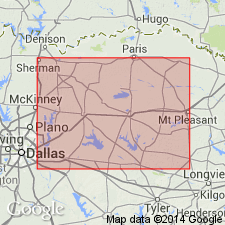
- Usage in publication:
-
- Bells Sandstone Member
- Modifications:
-
- Named
- Biostratigraphic dating
- Dominant lithology:
-
- Sandstone
- AAPG geologic province:
-
- South Oklahoma folded belt
- Ouachita folded belt
Summary:
Named as member in upper Eagle Ford Formation for the town of Bells, Grayson Co, TX in the South Oklahoma folded belt province. [Composite stratotype] consists of measured sections "presented for typic definition." Occurs in outcrop and subsurface in northern Collin and Grayson Cos, TX in the South Oklahoma folded belt province and in Fannin Co, TX in the Ouachita tectonic belt province. Formerly called Lake Crockett Sand Member (McNulty, 1954), herein abandoned. Areally restricted to the study area and not intended to supplant the subsurface Sub-Clarksville [sand] that is considered correlative. Is a southwest- and west-thinning tongue of [Woodbine-Tokio] lithosome on the northeast. Consists of as much as 46 ft of gray, brown-weathering, glauconitic quartz sandstone with interbedded glauconitic to jarositic shale. Overlies shale of Eagle Ford Formation with gradational contact. Underlies Maribel Shale Member with sharp contact. Assigned a late Turonian age on the basis of ammonites and stratigraphic position dating.
Source: GNU records (USGS DDS-6; Denver GNULEX).
For more information, please contact Nancy Stamm, Geologic Names Committee Secretary.
Asterisk (*) indicates published by U.S. Geological Survey authors.
"No current usage" (†) implies that a name has been abandoned or has fallen into disuse. Former usage and, if known, replacement name given in parentheses ( ).
Slash (/) indicates name conflicts with nomenclatural guidelines (CSN, 1933; ACSN, 1961, 1970; NACSN, 1983, 2005, 2021). May be explained within brackets ([ ]).

